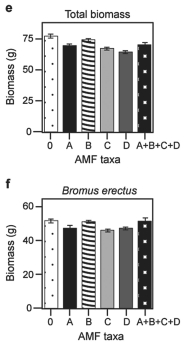Multiple Choice
Figure 31.5
Use the graphs in Figures 31.4 and 31.5 and the following information when answering the corresponding questions.
Canadian and Swiss researchers (van der Heijden et al. ,1998) ,interested in factors affecting biodiversity,grew a variety of grassland plants in combination with one of four arbuscular mycorrhizal (AMF) species,no AMF,or all four AMF species together;and they measured plant growth under each set of conditions.All plant species were grown in each plot,so they always competed with each other with the only difference being which AMF were present.Use the graphs in Figure 31.5 to answer the questions that follow.Note that the x-axis labels indicate the number and identity of AMF species (bar 0 = no fungi;bars A-D = individual AMF species;bar A+B+C+D = all AMF species together) .The y-axis indicates the amount (grams) of plant biomass for the species shown in italics above each graph.Graph (e) is the total biomass (grams) of all 11 plant species combined;graph (f) is the biomass of Bromus erectus plants only,separated from the total.


Figure 31.4 Figure 31.5
-What is the major difference between Bromus erectus (graph f) and the other plant species (graphs a-d) included in the study?
A) Bromus grows best with a diversity of fungal partners.
B) Bromus is unaffected by AMF diversity.
C) Bromus does not form mycorrhizal associations.
D) Bromus produces very little biomass regardless of AMF.
Correct Answer:

Verified
Correct Answer:
Verified
Q8: Figure 31.5<br>Use the graphs in Figures 31.4
Q8: Why is it important that ectomycorrhizal fungi
Q9: Based on the idea that fungi have
Q9: Fungi have an extremely high surface-area-to-volume ratio.What
Q10: You observe the gametes of a fungal
Q12: Figure 31.4<br>Use the following information when answering
Q14: Which of the following is an important
Q16: Microsporidians are considered parasitic because of the
Q17: Figure 31.4<br>Use the following information when answering
Q18: Use the following information when answering the